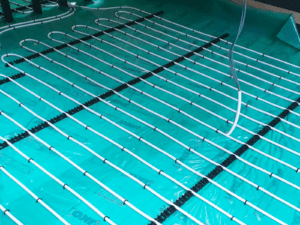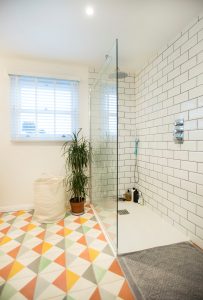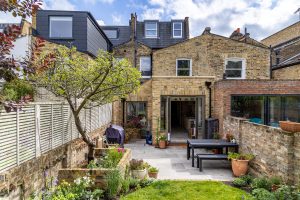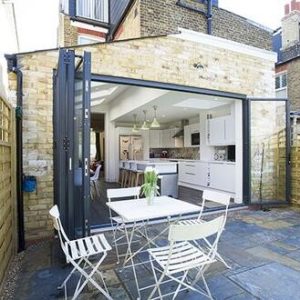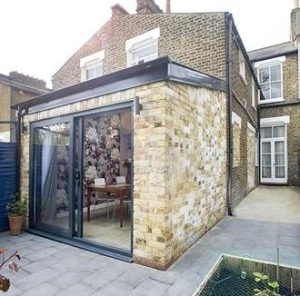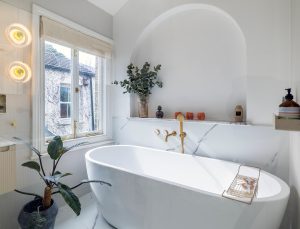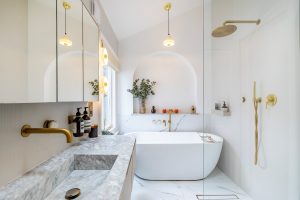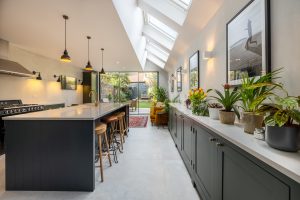Designing a bathroom is all about striking a balance between style and functionality to create a space that is beautiful and feels both calm and peaceful.
Whether you are planning a small family bathroom or a luxury ensuite, following our top 10 key principles will help you achieve a bathroom that looks really good and works perfectly for everyday life. Here are the golden rules to keep in mind:
01 – Smart Storage Solutions
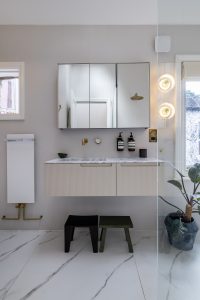
The key requirement for a well-designed bathroom starts with smart storage solutions. Without it, even the most beautiful bathroom will soon look cluttered. It is important to understand who will be using the bathroom and how often. A family bathroom demands much more storage, for example, than a guest ensuite.
In small bathrooms, vertical storage is a real game-changer. Tall, slim cupboards, wall-mounted cupboards and floating shelves all provide storage without taking up any precious floor space. Recessed niches near the shower or bath can be used for hidden storage that looks sleek and modern. For contemporary layouts, modular vanity units and mirrored cabinets are really practical, whilst keeping everything streamlined and tidy.
If using built-in storage is not possible, there are some good stand-alone solutions available on the market, including wicker baskets, colourful stacking boxes and even stylish ladders, which can all add storage and character to the bathroom. Plenty of storage ensures that surfaces can be kept clean and tidy, essentials are kept organised, and the aesthetic of the room remains calming.
02 – Functional Layouts (With Accessibility in Mind)
A beautiful bathroom needs to function well. When planning the layout, it is essential to ensure that the space will support daily routines with ease.
Start with the basics. The position of the bath, shower, wash basin and toilet should feel natural and uncluttered. Check that shower doors can be opened easily and there is room to manoeuvre easily around the basin and toilet. If you are planning drawers in a vanity unit, can they be easily opened?
If more than one person is going to use the bathroom at the same time and there is space, a double vanity could work well. For ease of accessibility for everyone, wider doorways, walk-in showers and grab handles are all useful additions.
Good layouts feel effortless and comfortable and make cleaning easier.
03 – Lighting Layers: Natural and Artificial Harmony
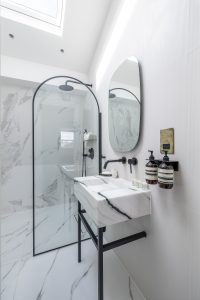
Lighting has a huge impact on the look and feel of a bathroom. The trick is to use multiple layers to create the perfect blend between function and ambiance.
Natural light – if you have some is ideal. Large windows, skylights and frosted glass can all brighten the space without compromising privacy. Additional lighting can be built in layers:
- Ambient lighting: offers soft, overall illumination for everyday use.
- Task lighting: especially around mirrors is ideal for ensuring shadow-free grooming.
- Accent lighting: LED strips under vanity units or within recesses add mood and depth.
Warm white LED lighting is still the most popular choice as it offers energy efficiency and a spa-like ambiance.
04 – Colour Palette: Trending Tones for 2025/26
Your chosen colour palette helps set the mood for your bathroom. Current popular colour schemes are leaning towards warm neutrals, earthy tones and spa-inspired palettes.
Timeless shades such as soft white, oatmeal, pebble grey and warm taupe all create a calm and airy atmosphere and work really well in small bathrooms as they help reflect the light. The earth inspired shades of sage, clay and warm stone provide an organic tranquillity, whilst feeling very modern.
Rich tones are trending too, as they add a sense of style and drama to a room. Colours such as navy, forest green and terracotta can all look luxurious and can be used on feature walls, cabinets and wall tiles. Be careful, though, as they do make rooms look smaller.
If you need your chosen bathroom colours to last, choose a neutral palette and introduce bolder colours with towels and accessories.
05 – Finishing Touches & Materials
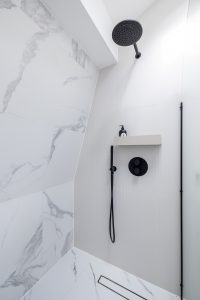
The clever use of materials helps define your bathroom’s style, texture and character. Current styles are spotlighting natural, tactile finishes that add warmth and depth to the space.
Popular additions include stone-like tiles, limewashed walls and brushed brass or matt black taps. Fluted finishes, textured and t ceramics and timber accents are all popular. Contrasting textures can work really well, for example, smooth porcelain paired with warm-coloured timber, which adds character richness to the room.
When choosing surfaces, it is important to consider ease of maintenance. Non-porous tiles, sealed stone and high-quality grout can all keep the space looking really good, with minimal effort.
06 – The Minimalist Principle
Modern bathrooms tend to be minimalist in design. The balance that must be struck is for the space not to look cold and clinical but calming. Clear surfaces, uncluttered lines and clever storage help to achieve this by creating a space where it is possible to unwind.
Using bibliophilic features can enhance this effect. Choose natural shapes and patterns, soft neutral tones and organic materials plus greenery to echo the tranquil beauty of nature and give your bathroom a serene ambiance.
07 – Sustainable Bathroom Design
Homeowners are prioritising eco-friendly choices now more than ever, and there are some excellent water-saving fixtures that can be used in the bathroom, including low-flow toilets, aerated taps and efficient rain showers that reduce consumption but not comfort.
Natural and recycled materials can be used in your bathroom design, including reclaimed timber, recycled tiles and bamboo furniture, which add character and style whilst reducing your environmental footprint.
Using energy-efficient ventilation and insulation improves air quality, prevents mould and maintains a comfortable temperature in the room and at the same time, lowers energy bills.
08 – Dramatic Features & Focal Points
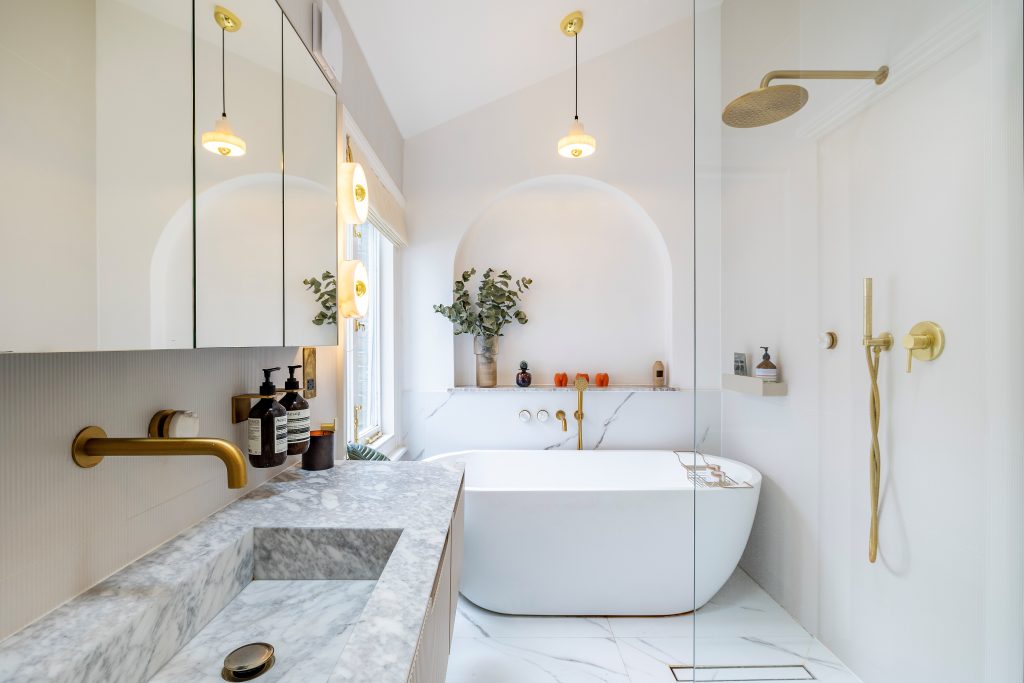
There is a growing trend to create statement features in different rooms in the house. These can be chosen to add style and character to a space. In bathrooms, this works well if there is space. Freestanding bathtubs are high on the list as they add drama and luxury.
Feature walls with beautiful tiles are also popular, as are oversized mirrors and unusually shaped basins. The important thing to remember is that large pieces can dominate and make a smaller bathroom feel crowded.
09 – Smart Technology & Innovations
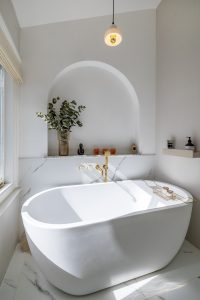
Smart technology is helping to shape the modern bathroom in many ways. Motion-sensor taps are good for hygiene, and heated mirrors keep them clear on busy mornings. Underfloor heating systems save space and energy and offer luxurious warmth at bath time!
Digital showers and thermostats control temperatures perfectly and reduce water waste. Smart mirrors have integrated lighting, Bluetooth speakers and touch controls that make everyday routines so much easier and more efficient.
10 – Wellness and Spa-inspired Design
The bathroom is now regarded by many as their personal sanctuary; a place to unwind, reset and recharge. Incorporating wellness features can elevate your space from functional to relaxing and restorative.
Rainfall showers, freestanding bathtubs, aromatherapy diffusers and soft lighting all give a spa-like ambiance to your bathroom. Adding soft towels, bath trays, leafy green plants and even a comfortable chair can help boost the home-spa experience.
A well-planned bathroom design is essential for creating a space that is practical, stylish and built to last. Applying our 10 principles will help you to achieve a bathroom that is efficient and luxurious and is tailored to your lifestyle. The right design will boost your everyday comfort and add value to your home.
If you are ready to update your bathroom or need expert advice on layout, fixtures and finishes, we are here to help. Contact us today for personalised advice and support that will bring your renovation plans to life.
- BuildTeam, 342 Clapham Road, London SW99AJ. Telephone 020 7495 6561


